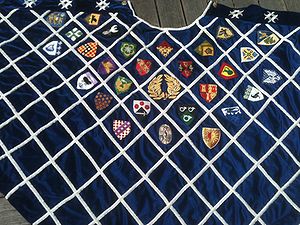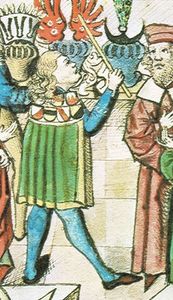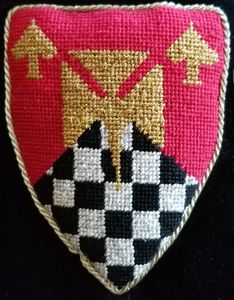Heraldic Mantle of Giles Hill: Difference between revisions
BaronGiles (talk | contribs) (Initial page creation and population) |
BaronGiles (talk | contribs) (added information on freelance heralds) |
||
| Line 2: | Line 2: | ||
Medieval heralds generally worked for a single patron (which could be a monarch or other nobility, or an Order of chivalry). When speaking for the principal, the herald would wear a tabard bearing the arms of their patron, symbolizing the fact that the herald spoke not on their own behalf, but with the voice of their liege. Some heralds, however, were available to be hired to speak for anyone needing their services, and publicized this by wearing mantles bearing the arms of their various employers. | Medieval heralds generally worked for a single patron (which could be a monarch or other nobility, or an Order of chivalry). When speaking for the principal, the herald would wear a tabard bearing the arms of their patron, symbolizing the fact that the herald spoke not on their own behalf, but with the voice of their liege. Some heralds, however, were available to be hired to speak for anyone needing their services, and publicized this by wearing mantles bearing the arms of their various employers. | ||
Dr Lynsey Darby, the past-Archivist of the College of Heralds in London, reveals that Randolf Jackson, appointed Montorgeuil poursuivant by Henry VII in early 1486, provided heraldic services for the 135 Seigneurial families of Jersey. The Governor of Jersey, Matthew Baker, presented an expense claim<ref>The claim is preserved in the National Archives at Kew, and partly re-printed in the Rolls Series No24 and also cited in ms ‘38 B.18 p. 97’ by John Anstis, Garter KoA.</ref> for a Tabard provided for Montorgeuil, "broidered with the devices of many Houses"<ref> I am indebted to Julian Wilson, on the FaceBook "SCA Heraldry Unofficial Chat", for this information.</ref> | |||
The Society's heralds will typically wear a tabard displaying the arms of the territory they serve. Occasionally a tabard bearing personal arms will be seen; this may be in tournaments of great pageantry, like Crown Tournies or pas d'armes, or a court ceremony like a coronation or elevation to the peerage. But given the expense of creating a heraldic tabard, not only in materials, but in the artisan's labor, personal heraldic tabards are quite unusual. [[Giles Hill]] has provided heraldic services to various territories and individuals during his decades of activity in Ansteorra and Caid. | The Society's heralds will typically wear a tabard displaying the arms of the territory they serve. Occasionally a tabard bearing personal arms will be seen; this may be in tournaments of great pageantry, like Crown Tournies or pas d'armes, or a court ceremony like a coronation or elevation to the peerage. But given the expense of creating a heraldic tabard, not only in materials, but in the artisan's labor, personal heraldic tabards are quite unusual. [[Giles Hill]] has provided heraldic services to various territories and individuals during his decades of activity in Ansteorra and Caid. | ||
== | ==Images of freelance Heralds== | ||
<gallery widths=300px heights=300px perrow=3> | <gallery widths=300px heights=300px perrow=3> | ||
Image:Giles_GermanMantle1.JPG|Herald with tabard and baton Tirol, Anton: Wappenbuch - BSB Cod.icon. 310 [S.l.] Süddeutschland. | Image:Giles_GermanMantle1.JPG|Herald with tabard and baton Tirol, Anton: Wappenbuch - BSB Cod.icon. 310 [S.l.] Süddeutschland. | ||
Image:Giles_GermanMantle2.JPG|Konrad Grunenberg's Roll of 1483.. | Image:Giles_GermanMantle2.JPG|Konrad Grunenberg's Roll of 1483. | ||
Image:Giles_EnglishMantle.JPG|Julian Wilson heralds a Pas d'Arms at the Ancient Hospital and Almshouse of St. Cross, in Drachanwald, near West Dragonshire (Southern England excepting London). The devices on the tabard are those of Seigneurial families of Jersey in the late 15th C, courtesy of the Librarian of our local historical Socièté Jersaise. | |||
</gallery> | </gallery> | ||
Revision as of 08:46, 28 April 2020
| Regalia | ||||
|---|---|---|---|---|
 Cope of the Order of the Laurel | ||||
| Information | ||||
|
Medieval heralds generally worked for a single patron (which could be a monarch or other nobility, or an Order of chivalry). When speaking for the principal, the herald would wear a tabard bearing the arms of their patron, symbolizing the fact that the herald spoke not on their own behalf, but with the voice of their liege. Some heralds, however, were available to be hired to speak for anyone needing their services, and publicized this by wearing mantles bearing the arms of their various employers.
Dr Lynsey Darby, the past-Archivist of the College of Heralds in London, reveals that Randolf Jackson, appointed Montorgeuil poursuivant by Henry VII in early 1486, provided heraldic services for the 135 Seigneurial families of Jersey. The Governor of Jersey, Matthew Baker, presented an expense claim[1] for a Tabard provided for Montorgeuil, "broidered with the devices of many Houses"[2]
The Society's heralds will typically wear a tabard displaying the arms of the territory they serve. Occasionally a tabard bearing personal arms will be seen; this may be in tournaments of great pageantry, like Crown Tournies or pas d'armes, or a court ceremony like a coronation or elevation to the peerage. But given the expense of creating a heraldic tabard, not only in materials, but in the artisan's labor, personal heraldic tabards are quite unusual. Giles Hill has provided heraldic services to various territories and individuals during his decades of activity in Ansteorra and Caid.
Images of freelance Heralds
- Giles EnglishMantle.JPG
Julian Wilson heralds a Pas d'Arms at the Ancient Hospital and Almshouse of St. Cross, in Drachanwald, near West Dragonshire (Southern England excepting London). The devices on the tabard are those of Seigneurial families of Jersey in the late 15th C, courtesy of the Librarian of our local historical Socièté Jersaise.
's allegiance was Inspired by the Descriptive text
Specifications for Personal Arms on the Mantle
The (approximate) finished dimensions are 4" tall, 3.5" wide. They are canvaswork (also called tentwork and needlepoint) worked on 18 - 22 count needlepoint canvas, in cotton, linen, or silk.
Personal Arms on the Mantle
Augustine von Freiburg
Per chevron gules and checky sable and argent, a cross formy fitchy and in chief 2 card-piques Or. Sir Augustine was elevated to the Order of the Chivalry on October 6, 2007 by Drogo and Iðuna, King and Queen of Caid. On September 5, 2010 he was elevated to the Order of the Pelican by Conrad and Eleanor, King and Queen of Caid.
![Herald with tabard and baton Tirol, Anton: Wappenbuch - BSB Cod.icon. 310 [S.l.] Süddeutschland.](/images/thumb/Giles_GermanMantle1.JPG/177px-Giles_GermanMantle1.JPG)

